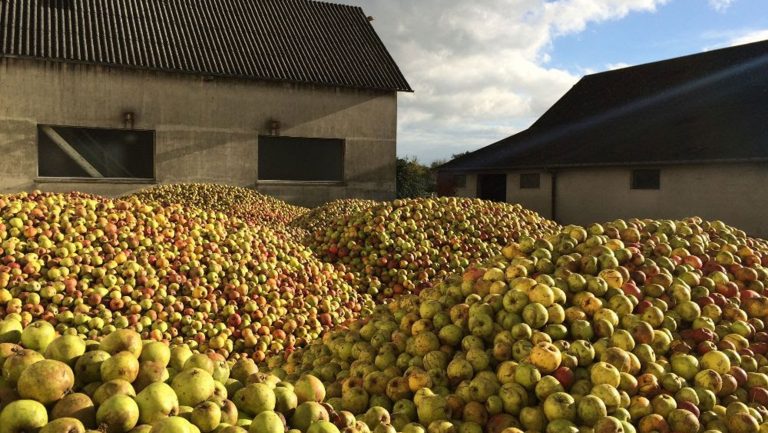“Craft distilleries are all popping up in places that have cheap real estate,” says Todd Thrasher, standing next to the construction site where his Potomac Distilling Company was rising amid sleek glass towers along the Potomac River in downtown Washington, D.C. That’s decidedly not the case for Thrasher’s distillery, which is slated to open in October.
He chose to open his distillery and bar in the middle of one of the splashiest, priciest, highest-profile developments in the nation. Called District Wharf, the project covers 27 acres along the Potomac River, about a 10-minute walk to the Smithsonian and the Mall. When completed, the $2.5 billion project will include 3.3 million square feet of residential, office, and retail space, along with performance venues and three pubic wharfs. Not surprisingly, rents here aren’t industrial-park cheap—retail spaces are going for an estimated $40 to $50 per square foot, and that’s before factoring in taxes, insurance, and maintenance, which could add another 20 to 40 percent to rents. In contrast, industrial space in the U.S. averaged about $5.50 a square foot in early 2018.
So how can you make a distillery work when facing such daunting numbers? Thrasher is banking on three elements: compact distillery size, on-premise sales, and high volume.

Don’t miss the latest drinks industry news and insights. Sign up for our award-winning newsletters and get insider intel, resources, and trends delivered to your inbox every week.
This is Thrasher’s first venture in distilling but far from his first enterprise. The longtime bartender put his name on the cocktail map when he opened PX in nearby Alexandria a dozen years ago, attracting fans to the bar’s speakeasy vibe and sophisticated cocktails. Thrasher has since been involved with about a half-dozen other bars in the D.C. area, including one at The Line DC hotel, which opened earlier this year.
A few years ago, Thrasher was approached by one of the Wharf’s developers about opening a branch of PX there. He initially demurred—the intimacy of PX didn’t lend itself to the scale or costs of the Wharf—but the developer got his attention when he asked whether Thrasher would consider a new bar-restaurant venture built around a distillery. Thrasher liked the idea and took a hard look at the craft spirits market. “There was a ton of gin, and bourbon is sexy but you have to age it,” he says. He didn’t want to be yet another distillery-bar pushing white-dog cocktails.
Then he looked at rum, his favored spirit since his college days. This seemed promising, so he set about educating himself, taking classes on rum making at Moonshine University in Louisville, Kentucky, and learning from other distillers. He immersed himself in licensing procedures, then ordered a 200-gallon Corson still and four 200-gallon fermenters. He and his wife are the sole owners of Potomac Distilling, which he pegs as a $1.8 million investment.

To keep costs down, Thrasher is operating his distillery in a compact space—he’s set aside just 992 square feet for production, or less than a quarter of the size of the average McDonald’s restaurant.
He aims to distill five days a week, producing several Thrasher Rums, including spiced, white, and gold versions—the latter possibly given color with time in madeira barrels. “The thing with craft spirits is that you can try stuff, and if it doesn’t work, you can try it again,” Thrasher says. He will also make a second spiced rum that’s heavy on botanicals, with the aim of appealing to gin lovers. Overall, he hopes his rums will have a Demerara-style quality—not as funky as Jamaican-style rums but offering some backbone for mixing in cocktails.
Thrasher also plans to fill one 53-gallon barrel a week to set aside for aging. He’d hoped to have an aging area in the bar, but getting a separate bonded location proved too difficult. So he’s made room for 100 barrels within the bonded distillery. The space doesn’t offer enough room to operate a forklift (although he has a pallet jack), so Thrasher says barrels will remain in place and will be emptied and filled with hoses and pumps. “I want to become so wildly successful,” he says, “that I can buy a warehouse in Southeast Washington or elsewhere” for additional aging when the time comes.
The distillery is essentially embedded within a two-story bar and restaurant—which has about 1,800 square feet inside, and a similar area on terraces with water views. Thrasher figures he can accommodate about 100 patrons inside, tripling that when the weather allows him to open garage-style doors to the terrace seating.
And he hopes the customers will be drinking lots of Thrasher’s Rum in cocktails. “This is not going to be one of those places with a million types of rum,” he says. “Thrasher’s will be in a lot of the cocktails—as will El Dorado and Appleton.” By moving more of his own rum across the bar, he’ll capture more value per ounce.
While customers will be able to buy bottles at the distillery (the anticipated shelf price will be under $30), Thrasher can earn more than $100 a bottle by selling it in drinks. In this, he’s following other distillers who’ve benefited from local laws allowing sales by the glass, which in turn has followed the mantra of the craft brewing market—Brew local, sell local.
It’s as yet unclear whether the craft distillery industry can succeed with this approach. Stills are more complicated than brewing equipment and public safety requirements are higher, given the potentially explosive fumes produced—all of which adds to the cost. What’s more, excise taxes on spirits are higher than those on beer and wine, meaning that more of each sale goes to the government and less to the distiller.
That leads many distillers to choose locations in low-priced industrial areas or the edges of towns, where rents are cheap—which means they need to become destinations to generate traffic. Thrasher is counting on the Wharf being a built-in, high-traffic destination all on its own. His distillery has a 74-foot brick smokestack with the Thrasher Rum logo painted on it, making it an instant landmark for the 275,000 people a day crossing the Francis Case Memorial Bridge, which all but arcs over Potomac Distilling. The developer projects that as many as 100,000 people will visit the Wharf on a busy weekend, and about 1.5 million people live within 25 minutes. A 6,000-seat concert venue is just a short walk away and is also expected to boost foot traffic.
Thrasher hopes to attract customers not only with the operating distillery but with a fun, relaxed, rummy vibe. The bar and restaurant are being managed by Michael Saccone, who worked with Thrasher at PX in the past and has signed on here as a partner. The menu will feature both classic and updated tiki-inspired drinks, served in an environment that Thrasher describes “more like an expat bar in Fiji than a tiki bar in Los Angeles around 1950.” And, he adds, “we’re definitely going to have red Solo cups involved.”
Thrasher hopes that by keeping production footage down, profit margins up, and customers teeming, the numbers will work. But “it’s a lot more stressful than just opening a restaurant,” he admits. “I’m usually a very good sleeper, but with this project, I’ve been waking up in the middle of the night: Did I buy the right stuff? Do I have enough time?”
Of course, Thrasher is hoping for big things over the long run—ramping up production and aging eventually, and creating a rum that people will notice and seek out. “I hope I can leave a lasting legacy that tastes good,” he says, “and will be on the shelves for years and years to come.”

Dispatch
Sign up for our award-winning newsletter
Don’t miss the latest drinks industry news and insights—delivered to your inbox every week.
Wayne Curtis is the author of And a Bottle of Rum: A History of the New World in Ten Cocktails and has written frequently about spirits for The Atlantic, Imbibe Magazine, Punch, The Daily Beast, and Garden & Gun, among others.







